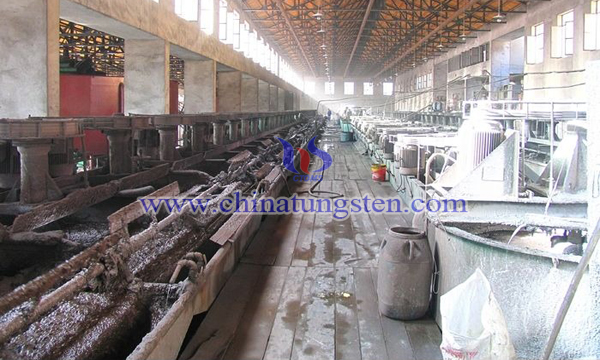Tungsten Trioxide Recycling from Tungsten Slag
- Details
- Category: Tungsten Information
- Published on Sunday, 01 July 2018 17:40
Tungsten slag is a waste residue produced by tungsten smelting enterprises in the process of pressure leaching. The pressure leaching process is based on a standard tungsten ore with a content of 65% of tungsten ore after ore dressing and adding additives. Under high temperature and high pressure alkaline conditions, after wet decomposition or fire decomposition, tungsten primary products such as sodium tungstate, calcium tungstate and ammonium para tungstate are obtained and the fineness is more than 100 orders of tungsten residue, each of which is produced. The output of a ton of WO3 primary products and the discharge of about 0.8 tons of tungsten slag at the same time, with the exhaustion of resources, the recovery of tungsten slag is of great significance.

A process for producing tungsten trioxide by ball baking with tungsten slag is characterized in that the following steps:
After drying the tungsten slag into anthracite, mixed and comminuted, then adding caustic mud, sodium carbonate and water, the ball plate is made to make the ball of tungsten slag, the addition amount of anthracite is determined by the calorific value of coal and the calcination temperature, which is 5~10% of the quality of tungsten slag.
The mixed ball of tungsten slag was put into a calcining kiln of a hearth furnace and the calcined temperature was 720~820°C, the calcining was completed after the calcining was completed, then the material of the kiln was prepared and the tungsten slag clinker was obtained. The roasted flue gas was emptied after three stages of NaOH solution.
The tungsten slag clinker is soaked in soaking pit or soaking barrel to obtain sodium tungstate mother liquor and waste residue. The mother liquor of sodium tungstate is obtained by ion exchange, and the mother liquor of high concentration sodium tungstate is obtained.
The mother liquor of high concentration sodium tungstate is filtered after removing impurities such as phosphorus, silicon and arsenic by magnesium salt method, then adding calcium chloride or calcium hydroxide or calcium sulfate into the filtrate, and precipitates, dehydrated, dried to obtain calcium tungstate products.
The characteristics of the process are that there are only CO2 and a small amount of CO and SO2 in the flue gas produced by roasting, which can be discharged directly after three stage spray of NaOH solution, the spray liquid produced can be used as ion regenerative liquid in ion exchange. After the roasted tungsten slag clinker is soaked in cold water, sodium tungstate is dissolved in water. The leaching solution, the mother solution of sodium tungstate, is up to 720mg/g temperature resin through the ion exchange capacity. It is easy to be eluted and regenerated and washed reliably. The wastewater in the ion exchange adsorption process, the waste water produced during the precipitation process and the regenerated waste water of the resin are added to the ion exchange solution after NaOH treatment, and the rest of the waste water is added to the ball, which achieves the zero discharge of the waste water and achieves a reliable environmental protection and makes full use of the large amount of waste water. The sodium ion also greatly reduces the dosage of additives and the cost of production.
- Tungsten Manufacturer & Supplier, Chinatungsten Online: www.chinatungsten.com
- Tungsten News & Prices of China Tungsten Industry Association: www.ctia.com.cn
- Molybdenum News & Price: news.molybdenum.com.cn
- Tel.: 86 592 5129696; Fax: 86 592 5129797; Email: sales@chinatungsten.com



 sales@chinatungsten.com
sales@chinatungsten.com